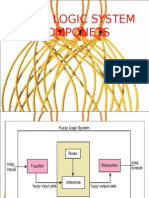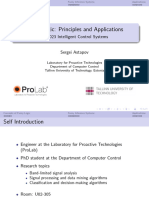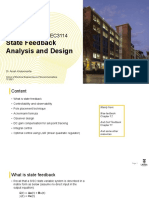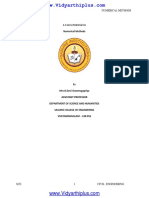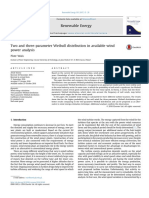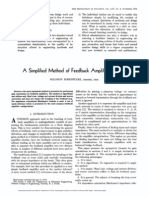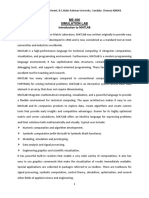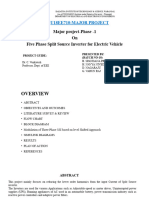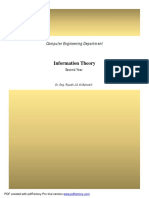Fuzzy Logic
Fuzzy Logic
Uploaded by
Jigar PatelCopyright:
Available Formats
Fuzzy Logic
Fuzzy Logic
Uploaded by
Jigar PatelOriginal Title
Copyright
Available Formats
Share this document
Did you find this document useful?
Is this content inappropriate?
Copyright:
Available Formats
Fuzzy Logic
Fuzzy Logic
Uploaded by
Jigar PatelCopyright:
Available Formats
1
DEPT OF EEE | NMIT
VISVESVARAYA TECHNOLOGICAL UNIVERSITY
JNANA SANGAMA, BELGAUM-590 014
A Technical Seminar Report on
SPEED CONTROL OF DC MOTOR BY FUZZY LOGIC
By
MANASA NAIK
1NT09EE023
DEPT OF EEE
Under the Guidance of
Prof. SRIDEVI H R
Senior lecturer,
DEPT OF EEE
Department of ELETCTRICAL AND ELECTRONICS ENGINEERING
NITTE MEENAKSHI INSTITUTE OF TECHNOLOGY
BANGALORE-64
2
DEPT OF EEE | NMIT
NITTE MEENAKSHI INSTITUTE OF TECHNOLOGY
BANGALORE 64
(An autonomous college under VTU, Belgaum)
Department of Electrical and Electronics Engineering
CERTIFICATE
Certified that Ms. Manasa Naik, 1NT09EE023, a bonafide student of Nitte
Meenakshi Institute of Technology, Bangalore has submitted the technical report
on the seminar entitled SPEED CONTROL OF DC MOTOR BY FUZZY
LOGIC in partial fulfillment for the award of Bachelor of Engineering in
Electrical and Electronics Engineering during the year 2012-2013.
Signature of the Reviewer Signature of the Incharge Signature of the HOD
3
DEPT OF EEE | NMIT
ABSTRACT
Fuzzy logic is a powerful problem solving methodology with wide range of application in
industrial control. This paper concentrates on the speed control of D.C Motor using fuzzy logic.
An attempt is made in developing efficient rule based constant speed dc drive by fuzzifying the
controller input.The idea behind the Fuzzy logic controller is to fuzzify the controller inputs then
infer the proper control decision based on defined rules. The fuzzy logic controller (FLC) output
is then produced by defuzzifying this inferred control decision. Thus fuzzification, rule definition
and defuzzification forms the basic process of fuzzy logic controller.A FLC uses motor speed as
input and measures difference of speed with respect to target speed. Assuming symmetrical and
50% overlapping with adjacent triangular membership function for five linguistic variables;
controller gives the voltage proportional to fall in speed. When the motor is loaded, this voltage
is fed to armature to make the motor to run at rated speed.A well accepted separately excited
D.C.Machines mathematical model is used for the simulation. As the load current increases, due
to armature resistance voltage drops across it increases and hence the speed of the motor
decreases. Speed of dc motor using FLC at different load currents is obtained which reveals that
almost constant speed is maintained at its operating range
4
DEPT OF EEE | NMIT
CONTENTS
1.INTRODUCTION (5)
2. LITERATURE REVIEW ..(7)
2.1 DIFFERENT CONTROLLING METHODS .(7)
2.2 FUZZY SYSTEM(9)
MEMBERSHIP FUNCTION(11)
WORKING OF A FUZZY SYSTEM .(12)
3. MATHEMATICAL MODEL OF A DC MOTOR (15)
4. DESIGN OF F.L. (21)
4.1 INTRODUCTION (21)
4.2BLOCK DIAGRAM OF FLC..(21)
4.3IMPLEMENTATION OF FLC (23)
CONSTRUCTION OF MEMBER FUNCTION .(24)
5. RESULTS AND DISCUSSIONS (29)
6. CONCLUSIONS (31)
BIBLOGRAPHY...(32)
5
DEPT OF EEE | NMIT
ABSTRACT:
Fuzzy logic is a powerful problem solving methodology with wide range of application in
industrial control. This paper concentrates on the speed control of D.C Motor using fuzzy logic.
An attempt is made in developing efficient rule based constant speed dc drive by fuzzifying the
controller input.The idea behind the Fuzzy logic controller is to fuzzify the controller inputs then
infer the proper control decision based on defined rules. The fuzzy logic controller (FLC) output
is then produced by defuzzifying this inferred control decision. Thus fuzzification, rule definition
and defuzzification forms the basic process of fuzzy logic controller.A FLC uses motor speed as
input and measures difference of speed with respect to target speed. Assuming symmetrical and
50% overlapping with adjacent triangular membership function for five linguistic variables;
controller gives the voltage proportional to fall in speed. When the motor is loaded, this voltage
is fed to armature to make the motor to run at rated speed.A well accepted separately excited
D.C.Machines mathematical model is used for the simulation. As the load current increases, due
to armature resistance voltage drops across it increases and hence the speed of the motor
decreases. Speed of dc motor using FLC at different load currents is obtained which reveals that
almost constant speed is maintained at its operating range
1.INTRODUCTION
In the present era of utility, degradation and complication many utility and industrial customers
are concerned about reliable operation of electric motor and quality of power. Recently speed controls are
used for wide variety of operation used in industry domestic and research works. Most of the drives work
on this rotating machine.
Speed control means intentional change of the drive speed to a value required for performing the
specific work process as per the requirement. The desired change in speed is accomplished by acting
accordingly on the drive motor or on the transmission connecting it to the unit it serves to drive.
Electric motors are used to drive loads of varying characteristics. Precise speed control of electric
motors in either direction or their constant speed operation under varying load conditions is required in
different applications in industries, electric traction and machine tool etc to attain a high rate of
production, high quality of products and at the same time to achieve economy in production.
Speed control is required to a high degree of accuracy. Some of the features like range,
smoothness, economic justifiability, and stability of operation and direction of speed control have to be
considered. The operation of speed control was first carried out through some of the mechanical methods.
6
DEPT OF EEE | NMIT
Speed can be adjusted mechanically by means of stepped pulleys, set of change gears, variable speed
friction clutch mechanisms and other mechanical devices.
Speed can also be controlled by some of the electrical methods such as varying flux per pole (flux
control), resistance of the armature circuit (rheostatic control); applied voltage (voltage control).these
methods are applied to shunt, compound and series motor.
The electrical speed control has many economical as well as engineering advantages over mechanical
speed control methods. The traditional control model does not handle a variety of objects with differing
material characteristics very well and are based on mathematical models in which the control system is
described using one or more differential equations that define the system response to is inputs. Such
systems are often implemented as proportional integral derivative (PID) controllers. They are the
products of decades of development and theoretical analysis and are highly effective.
But these traditional speed control methods have got their own drawbacks, which can be
efficiently over come by applying fuzzy logic control.
The concept of fuzzy logic was conceived by lotfi Zadeh, a professor at the University of
California at Berkley. An organized method for dealing with imprecise data is called fuzzy logic. The data
are considered as fuzzy sets. Fuzzy sets allow partial membership. Fuzzy logic provides a means of
calculating intermediate values between absolute true and absolute false with resulting values ranging
between 0.0 and 1.0.
A fuzzy logic controller uses fuzzy logic as a design methodology, which can be applied in linear
and non-linear system for embedded control. The idea behind the fuzzy logic controller is to fuzzify the
controller inputs than infer the proper fuzzy control decisions based on defined rules. Defuzzifying this
inferred control decision then produces the fuzzy logic controller output.
Fuzzy logic is a problem solving control system methodology that lends itself to implementation
in systems ranging from simple, small, embedded micro controllers to large, networked multi channel PC.
It can implement in hardware, software or a combination of both. Fuzzy logic provides a simple way to
arrive a definite conclusion based upon vague, noisy or missing input information. Simplicity of fuzzy
logic in FLC enables the control designers to realize a control in less development time, at lower
development cost and with better performance.
A fuzzy logic based controller (FLC) has been developed to perform the function of speed
controller by providing controlled voltage to the D.C. machine. The complete range for variation of
controller input is represented by five decisions.
7
DEPT OF EEE | NMIT
The application of speed control of drives using fuzzy logic was first introduced in the controlling
of kiln controllers in cement mills. Later it finds an important place in controlling of many industrial
drives such as steel mills, coal mills etc. It also finds its use in household appliances such as vacuum
cleaners, washing machines etc. even the field of automobiles is not beyond the reach of fuzzy logic.
2. LITERATURE REVIEW
2.1 DIFFERENT CONTROLLING METHODS:-
Speed control can be done manually by the operator or by means of some automatic
control device. There are number of methods of mechanically varying the speed of the driven
load when the driving motor is operating at a constant speed, these are typically belt drive, chain
drive, gear box, idler wheel drive.
In these methods, coupling ratio alters the speed of the driven load. These mechanical
methods allow a dynamic speed variation but are less common and more expensive.
Some of the electrical methods to control the speed of D.C.Motor are Field rheostat
control method, armature resistance control method and voltage control method.
FIELD RHEOSTAT CONTROL METHOD:-
In this method, speed variation is accomplished by means of a variable resistance inserted
in series with the shunt field. An increasing controlling resistance reduces the field current with a
consequent reduction in flux and increase in speed. This method of speed control is very simple,
convenient and most economical and is therefore, extensively used in modern electric drives.
This method of speed control is independent of load on the motor and permits remote control of
speed.
ARMATURE RESISTANCE CONTROL:-
8
DEPT OF EEE | NMIT
This method consists simply of a variable resistance connected in series with the
armature. The speed at full load may be reduced to any desired value depending on the amount
of resistance. With this method, the voltage across the armature drops as the current passes
through the series resistance and the remaining voltage applied to the armature is lower than the
line voltage. Thus the speed is reduced in direct proportion to this voltage drop at the armature
terminals. Wide range of speed can be obtained by this method and at the same time motor will
develop any desired torque over its operating range, since the torque depends upon the armature
current, flux remaining unchanged.
ARMATURE VOLTAGE CONTROL: -
This method of speed control requires a variable source of voltage separate from the
source supplying the field current. This method avoids the disadvantages of poor speed
regulation and low efficiency. The adjustable voltage for the armature is obtained from an
adjustable voltage generator or from an adjustable electronic rectifier. This method gives a large
speed range with any desired number of speed points. It is essentially constant torque system,
because the output delivered by the motor decreases with a decreasing applied voltage and a
corresponding decrease in speed.
Speed of a motor can also be varied by using mechanical methods depending upon the
type of drives and braking phenomenon to be evolved. These mechanical methods allow for a
dynamic speed variation but these are less common and more expensive.
The traditional control model does not handle a variety of objects with differing material
characteristics very well and are based on mathematical models in which the control system is
described using one or more differential equations that define the system response to is inputs.
Such systems are often implemented as proportional integral derative (PID) controllers. They
are the products of decades of development and theoretical analysis and are highly effective.
.Furthermore, fuzzy logic is well suited to low cost implementation based on cheap
sensors, low resolution analog to digital converters and 4-bit or 8- bit one chip micro controllers,
9
DEPT OF EEE | NMIT
and such systems can be easily upgraded by adding new rules to improve Performance or add
new features and even extra layer of intelligence to the current control method.
2.2 FUZZY SYSTEM:
A fuzzy system can be represented with the help of a block diagram as shown in figure 1.
Fig.1
Any fuzzy system consists of four major modules of the system
1. Fuzzification module.
2. Inference engine,
3. Knowledge base and
4. Defuzzification module.
The fuzzification module transforms the crisp input(s) into fuzzy values. These values are
then processed in fuzzy domain by inference engine based on knowledge base (rule base and
procedural knowledge) supplied by the domain expert (s). Finally the processed output is
transformed from fuzzy domain to crisp domain by defuzzification module.
FUZZIFICATION MODULE:-
Fuzzification is a process of mapping input values in crisp sets to values in fuzzy set. The
fuzzification module performs the following function.
10
DEPT OF EEE | NMIT
- Receives the crisp inputs. The input variables are scale mapped that transfers the range of
values of input variables into corresponding universe of discourse.
- Transforms the input crisp variables to fuzzy variables. The universe of discourse of
fuzzy variables is divided into fuzzy subsets. The input variable is mapped into these subsets
with varying grade of membership.
KNOWLEDGE BASE:-
This module contains the knowledge of the application domain and the procedural
knowledge such (as attendant control goals in the case of a fuzzy controller). It consists of a
database and linguistic (fuzzy) control rule base or production rules.
- The data base provides the necessary definitions, which are used to define linguistic
control rules and fuzzy data manipulation in an FLC.
- The rule base characterizes the control goals and control policy of the domain expert by a
set of linguistic control rules.
INFERENCE ENGINE:-
This module simulates the decision making capabilities of human brain. Based on input
from fuzzifier, domain knowledge and set of control rules the output decisions or the necessary
control actions are evaluated in fuzzy domain. Since usually more than the rules fire there are
more than one outputs at a given instant. Inference engine also takes into account this fact by
combining a number of fuzzy outputs into a single fuzzy set. This process of combining a
number of fuzzy sets into single fuzzy sets is called aggregation.
DEFUZZIFICATION MODULE:-
The defuzzification module performs the following functions:-
11
DEPT OF EEE | NMIT
- A scale mapping that converts the range of values of output variables into corresponding
universe of discourse.
- Defuzzifcation that transforms fuzzy outputs o corresponding crisp outputs for suitable
action.
MEMBERSHIP FUNCTION:-
In the Fuzzification, process of transferring the crisp control variables to corresponding
fuzzy variables. It is more common in the literature to use the output error and the derivatives of
the output as controller input .but for convenience, speed (N) has been selected as controller
input for the present problem.
Each of the FLC input and output signals are interpreted into a number of linguistic variables.
The number of linguistic variable varies according to the application and usually an odd number
is used .however, increasing the number of linguistic variables results in a corresponding
increase in the number of rules and also decrease the fuzzy characteristics. Adopting a
compromise, the reasonable number is five .Each linguistic variable has its fuzzy membership
function. The membership function maps the crisps values into fuzzy variable .A set of
membership defined for negative big (NB), negative minimum (NM), zero (Z), positive medium
(PM), positive big (PB) respectively.
The membership function is a graphical representation of the magnitude of participation
of each input. It associates a weighting with each of the inputs that are processed, define
functional overlap between inputs, and ultimately determines an output response.The rules use
the input membership values as weighting factors to determine their influence on the fuzzy
output sets of the final output conclusion. Once the functions are inferred, scaled, and combined,
they are defuzzified into a crisp output which drives the system. There are different memberships
functions associated with each input and output response.
Membership function is to be treated as the heart of the program where in all the major
part of calculation is done using the previous datas obtained. Generally membership function is
expressed graphically and tends to illustrate how a complete crisp variable belongs to fuzzy set.
12
DEPT OF EEE | NMIT
WORKING OF A FUZZY SYSTEM:-
To illustrate the working principle of a fuzzy system we consider here the computational
inferencing systems. A fuzzy systems working under the frame work of compositional
mechanism performs its computing as shown in figure 2, in the following 5 steps.
Fig.2
STEP 1:- FUZZIFICATION OF THE INPUTS
Fuzzification is the process of transformation of crisp input values to the corresponding
values in fuzzy domain (fuzzy values), in this step fuzzifier takes the inputs and determines the
degree to which they belong to each of the appropriate fuzzy sets via membership functions. The
input (s) is always a crisp numerical value.
STEP 2:- FUZZY OPERATORS
APPLY FUZZY OPERATOR
APPLY IMPLIFICATION
METHOD
AGGREGATE ALL
OUTPUTS
DEFUZZIFY
FUZZIFY INPUTS
13
DEPT OF EEE | NMIT
It is also called composition. Usually the antecedent of a given rule has more than one
part; hence the fuzzy operators are applied to obtain one number that represents the result of the
antecedent for that rule. This number will then be applied to the output function. The input to a
fuzzy operator is two or more membership values from fuzzified input variables. The output is
single truth-value. Two commonly used fuzzy operators are MIN and MAX operators.
STEP 3:- IMPLICATION METHODS:-
The shaping of the consequent based on the antecedent is termed as implication. The
input for the implication process is a single number given by the antecedent, and the output is a
fuzzy set (i.e. output of a fuzzy operator), implication is applied for each rule. Two commonly
used implication methods for AND are min (i.e. truncation) and product (i.e. scaling the height
of the fuzzy set). There are a large number of implication operators such as mamdani, Larsen,
godelian which are listed in the table shown below
IMPLICATION OPERATION AGGREGATION OPERATOR
Mamdani
Union ( )
Larsen
Union ( )
Lukasiewicz
Intersection ( )
Kleen-Dienes
Intersection ( )
Standard Sequence
Intersection ( )
Drastic Product
Union ( )
Zadeh
Intersection ( )
14
DEPT OF EEE | NMIT
STEP4:-AGGREGATE OF OUTPUTS:-
Aggregation is a process by which several fuzzy sets are combined in desirable way to
produce a single fuzzy set. Aggregation is obtained by combining all the fuzzy sets that represent
the output of each rule into a single fuzzy set. Aggregation only occurs once for each output
variable. For our model the input of the aggregation process is the list of truncated output
functions returned by the implication process for each rule. The output of the aggregation
process is one fuzzy set for each output variable. Designing of an aggregation process is trival,
because the coupling between implication operators and aggregation operators are suggested in
interaction. Aggregation operator performs either a union (OR) or an intersection (AND) among
the implication results. The Mamdani implication operator is used with union aggregation or
maximum inference.
STEP5:-DEFUZZIFICATION
Defuzzification transforms the fuzzy values (sets) to crisp values. The input for the
defuzzification process is a fuzzy set and the output is a single crisp number. Given a fuzzy set
that encompasses a range of output values; one number needs to be returned thereby moving
from a fuzzy set to a crisp output. The process of defuzzification in fuzzy systems is not a
standard one. There are numerous defuzzification methods available; however the popular
methods are listed below. Unfortunately, there is no theory to justify their behaviour, other than
commonsense reasoning such that the defuzzified output must represent a weighted, voted or
most suitable solution.
- Centre of gravity
Bounded product
Union ( )
Gougen
Intersection ( )
Godelian
Intersection ( )
15
DEPT OF EEE | NMIT
- Centre of sums
- Height defuzzication
- Centre of largest area
- Min max approach
- Weighted average.
From the above mentioned defuzzification methods the MIN MAX approach has been adopted.
The MIN MAX method tests the magnitudes of each rule and selects the highest one. The
horizontal coordinate of the "fuzzy centric" of the area under that function is taken as the output.
This method does not combine the effects of all applicable rules but does produce a continuous
output function and is easy to implement.
Defuzzification is especially necessary for hardware applications, because conventional
systems operate based on crisp data exchange.
3. MATHEMATICAL MODEL
EQUIVALENT CIRCUIT OF A SEPARATELY EXCITED D.C. MOTOR:-
Fig.3
16
DEPT OF EEE | NMIT
The equivalent circuit of D.C. Motor showing the field and armature winding is as shown in fig.3.
The armature has a certain amount of resistance,
a
R . When voltage is applied, a current,
a
I flows
through the armature. This armature current generates a magnetic field that interacts with the shunt
field (o ) causing rotation.
As the flux is constant throughout the operation, the field winding is directly connected across
the supply mains; therefore we can treat the system as a separately excited D.C. Motor.
MATHEMATICAL MODEL OF D.C MOTOR:-
When the armature and field are suitably connected to the supply the motor armature rotates,
the armature conductors cut the lines of force of the field, and as a result, they have emf induced in
them. The direction of one such induced e.m.f in an individual conductor given by Flemings right hand
rule and according to this rule the e.m.f is outwards to the current direction that is opposed to the
current. This induced e.m.f in the case of motor is therefore called the back e.m.f.
If the induced e.m.f in the armature is opposite in direction to the current then the
machine is motoring; if it is in the same direction as the current, the machine is generating; the
magnitude of the back emf is given by the expression for the generated emf calling the back
emf, we have
A
ZNP
E
b
60
o
= .. (1)
Where,
b
E =back emf in volts
N = speed in r.p.m.
o =flux in webers
17
DEPT OF EEE | NMIT
Z=number of armature conductors
P=number of poles
A=number of parallel paths
The voltage applied across the motor has to
1. Overcome the back emf
b
E and
2. Supply the armature ohmic drop
a
I
a
R
V =
b
E +
a
I
a
R . (2)
b
E = V -
a
I
a
R and
a
I =
|
|
.
|
\
|
a
b
R
E V
.. (3)
This is known as voltage equation of motor.
From the equations (2) and (3), back e.m.f depends among other factors, upon the
armature speed. If the speed is high,
b
E is large hence the armature current
a
I , as seen from the
equation (3) is small. If the speed is less, then
b
E is less hence more current flows which
develops motor torque. So, we find that
b
E acts as a governor.
In order to express the back e.m.f. equation in terms of voltage constant
v
K , equation
(1) is modified by Multiplying both the numerator and denominator by angular acceleration e
we get,
A
ZNP
E
b
60
o
= |
.
|
\
|
e
e
Substituting e = N t 2
18
DEPT OF EEE | NMIT
A
ZNP
E
b
60
o
=
|
.
|
\
|
N
N
t
t
2
2
=
|
.
|
\
|
|
.
|
\
|
60
2
2
t
t
o
A
ZP
In the above equation, |
.
|
\
|
A
ZP
t
o
2
is a constant called as voltage constant
v
K in volts/rad/sec.
b
E =
v
K
|
.
|
\
|
60
2t
N
where N is the armature speed in r.p.m
i.e, |
.
|
\
|
=
30
t setspeed K
E
v
b
As the supply voltage is normally constant, the back emf is almost equal to the applied
voltage during the no-load condition.
The back e.m.f under no-load condition is given by,
0 b
E = V -
a
I
a
R
Where,
0 b
E = no-load back e.m.f in volts.
V = terminal voltage in volts.
a
I = armature current in amperes.
19
DEPT OF EEE | NMIT
a
R = armature resistance in ohms.
The speed under no-load condition is related to back e.m.f as,
0
N E
bo
.. (4)
When load is applied on the motor, the armature current will increase due to which the
back emf will decrease thereby decreasing the speedof the motor normally to a value which is
not equal to the target speed.
The corresponding speed under load conditions is deduced below
1 1
N E
b
. (5)
(5)/ (4) gives
|
|
.
|
\
|
=
|
|
.
|
\
|
O bo
b
N
N
E
E
1 1
O
bo
b
N
E
E
N
|
|
.
|
\
|
=
1
1
(6)
To attain target speed we have to make the back emf sufficiently enough. The fuzzy or
crisp outputs will produce necessary values as outputs so that the back emf which is sufficiently
enough to attain target speed is obtained.
( ) t crispoutpu E E
b b
+ =
1 2
By using the back emf and speed relation to deduce relation for the target speed,
2 2
N E
b
20
DEPT OF EEE | NMIT
Where
2
N is the target speed
O bo
N E
|
|
.
|
\
|
=
|
|
.
|
\
|
bo
b
E
E
N
N
2
0
2
Therefore,
O
b
b
N
E
E
N
|
|
.
|
\
|
=
0
2
2
Hence as seen from the above equation, the target speed of the motor
2
N is obtained by
using the fuzzy or crisp outputs.
4. DESIGN OF FUZZY LOGIC
4.1 INTRODUCTION:
Design is a process of creating something new by implementing new concepts and new
arrangements. The essential part of fuzzy system design is the application of fuzzy sets and fuzzy
logic to a solution, provided in the conventional non fuzzy form.
It is generally valid that there are three sources of solutions for all kinds of problems.
These three sources also indicate three domains of knowledge representation: Natural language,
numerical data and closed form of mathematical formula.
The design challenge is to translate the knowledge given in one of these forms into fuzzy
IF-THEN rules.
21
DEPT OF EEE | NMIT
Motor
FLC
One step delay
U A
A fuzzy logic controller uses principle of fuzzy logic as a design methodology wherein a
program is written to measure the input and control the output, which can be applied in
developing linear and non-linear system for embedded control.
4.2 BLOCK DIAGRAM FOR FLC:-
Fig.4
For the system described, the output of the system is speed of the motor. Hence the
system is to be controlled in closed loop. Therefore the output speed (N) is fed as the feedback
signal for the closed loop.
FUZZY SYSTEMS:
A fuzzy inference system (or fuzzy system) basically consists of a formulation of the
mapping from a given input set to an output set using FL. This mapping process serves as basis
for which the inference or conclusion can be made. A fuzzy inference process consists of the
following five steps.
Step.1: fuzzification of input variables.
Step.2: application of fuzzy operator (AND, OR, NOT) in the IF (antecedent) part of the rule.
22
DEPT OF EEE | NMIT
Step.3: implication from the antecedent to the consequent (THEN part of the rule).
Step.4: aggregation of the consequence across the rules.
Step.5: Deffuzification.
A fuzzy system is defined as a system (mechanical, electrical) with operating principles
based on fuzzy information processing and decision-making. Designing a fuzzy system refers to
developing mechanism for fuzzy information processing and decision making within a digital
platform and soft computing environment.
4.3 IMPLEMENTATION OF FLC:-
fig.5
FUZZIFICATION:-
Fuzzification is the process of transformation of crisp control variable to corresponding
fuzzy variables.
In this project, we have selected speed (N) as the controller input variable.
23
DEPT OF EEE | NMIT
This input is used for fuzzification. In this step, fuzzifier takes the speed input and determines the
degree to which they belong (i.e. the region in the speed triangle) to each of the appropriate
fuzzy sets via membership functions. A set of membership functions is defined for five linguistic
variables negative big (NB), negative medium (NM), zero (Z), positive medium(PM), positive
big( PB).
CONSTRUCTION OF TRIANGULAR MEMBERSHIP FUNCTIONS FOR FIVE
LINGUISTIC VARIABLES:
The number of linguistic variables varies according to the application and usually an odd
number is used.
Following assumptions are made in construction of membership functions for five
linguistic variables to both input variable and control output.
1. symmetrical membership functions
2. 50% overlapping with adjacent functions
However increasing the number of linguistic variables resulting in corresponding
increases in the number of rules and also decrease the fuzzy characteristics. Adopting a
compromise the reasonable number is five. Each linguistic variable has its fuzzy membership
function. The membership function maps the crisp values into fuzzy variables. A set of
membership defined for five linguistic variables NB, NM, Z, PM, PB which stands for negative
big, negative medium, zero, positive medium, positive big respectively as shown in fig.
Assuming symmetrical membership function and 50% overlapping with adjacent function.
PROCEDURAL STEPS FOR CONSTRUCTION OF TRIANGLE ARE AS STATED
BELOW:-
Initially we require mean of the linguistic variables and is calculated by using formula.
Mean, x =
n
x x x x
n
......
3 2 1
+ + +
Where,
1
x ,
n
x x x .......... ,
3 2
are linguistic variables.
n is total number of linguistic variables.
24
DEPT OF EEE | NMIT
x is the mean of linguistic variable.
Thus the mean obtained will be used for the further calculation of deviation which is given by,
Deviation, d
1
=x
1
- x
Where,
1
x is the first data of linguistic variable .similarly deviation is calculated for all the data.
The average deviation is calculated by using formula,
D =
n
dn d d + + + ........ 2 1
D =
n
d
Where, D is the mean deviation
n
d d d ........ ,
2 1
are the deviation of the linguistic variables corresponding to
1
x ,
n
x x x .......... ,
3 2
n is total number of linguistic variables.
Finally standard deviation will be calculated as below :
25
DEPT OF EEE | NMIT
n
d d d
n
2 2
2
2
1
.......+ + +
= o =
n
d
i
2
where o = standard deviation.
The standard deviation obtained from the linguistic data s is used for construction of
triangle where in base of each triangle is 2o which gives more efficiency in fuzzy reasoning.
Thus the maximum and minimum range of speed is calculated using o 2 the formula
given below:-
X
min
= x - 2o
X
max
= x + 2o
i
26
DEPT OF EEE | NMIT
fig.6
Rule evaluation:
In general, fuzzy system maps input fuzzy sets to output fuzzy sets. Fuzzy rules are the
relation between input and output fuzzy sets. They are usually in the form of IF A THEN B.
where A is the rule antecedent and B is rule consequence. Each rule defines a fuzzy path in the
Cartesian product A x B (system space representation). The antecedents of each fuzzy rule
describe a fuzzy input region
For a system of one control variable with five linguistic variables, five rules are defined which
are as follows:
Rule 1: if speed is very low then v_set must be very high
Rule 2: if speed is low then v_set must be high.
Rule 3: if speed is set speed then v_set must be zero
Rule 4: if speed is high then v_set must be low.
Rule 5: if speed is very high then v_set must be very low
When the motor is running at the set speed (say at 1000 r.p.m), the incremental voltage to
be supplied from FLC is zero but if the speed of the motor decreases (i.e low), the incremental
voltage to be supplied is high (i.e. 6.75 V) which speeds up the motor to run at target speed.
27
DEPT OF EEE | NMIT
Fig.7
fig.8
28
DEPT OF EEE | NMIT
Implication method:-
The shaping of the consequent based on the antecedent is termed as implication. The input
for the implication process is a single number given by the antecedent, and the output is a fuzzy
set. Implication is applied for each rule.
In the implication process, two out of five rules will be activated based on the input variable.
Example;- if the speed of the motor is running at 900rpm, then N lies in the region
between SET and NM in the speed triangle hence depending on that speed two out of five rules
activated are as follows.
If speed is low then v_ set must be high.
If speed is set speed then v_ set must be zero.
AGGREGATION :( Rule grade Or Max .or Min. Inference)
The process of obtaining the overall consequent (conclusion) from the individual
consequents contributed by each rule in the rule base is known as aggregation of rules.
Aggregation operator performs either a union (OR) or an intersection (AND) among the
implication results. In aggregation process, two out of five rules which are implicated earlier are
aggregated into one fuzzy set.
An each rule activated above represents an individual output .the individual out puts
obtained are combined in to a single fuzzy set called as output fuzzy set.
DEFUZZIFICATION:
Defuzzification is a process of transforming the fuzzy values to the crisp values. The
input for the defuzzification is a fuzzy set and the output is a single crisp number.
Defuzzification is especially necessary for hardware applications, because conventional systems
operate based on crisp data exchange.
29
DEPT OF EEE | NMIT
In defuzzification process, an action will be activated for aggregated fuzzy set. Both rule
strength from the membership function and the activated action are substituted in the below
formula to get the desired crisp output.
This crisp output obtained is the controlling voltage,which is propotional to the fall in
speed which upon feeding to the armature makes the motor to run at target speed.
5. RESULTS AND DISCUSSIONS
This section discusses the results obtained from the speed control of separately excited
D.C. motor using FLC.
A separately excited motor has separate field and armature windings. The speed output of
the motor is varied by controlling the excitation on the armature winding while maintaining full
D.C. voltage on the field. The ratings of the machine used are given below
Applied voltage=220V
Armature resistance
a
R = 0.3 ohms
No-load current,
a
I =3 amps
Set speed=1000 r.p.m
( )
( )
=
=
=
N
l
N
l
rulegrade
gleton action rulegrade
crisps output
1
1
sin
) (
30
DEPT OF EEE | NMIT
When the rated voltage is applied across the motor armature it has to overcome back emf
and supply the armature ohmic drop.
a
I
a
R
V =
b
E +
a
I
a
R
This is known as voltage equation of a motor.
The armature current is given by,
a
I =
|
|
.
|
\
|
a
b
R
E V
The speed v/s armature current of separately excited D.C. motor with and without using FLC are
as shown in fig.9
fig.9
31
DEPT OF EEE | NMIT
From the characteristics curve (without using FLC) as load on motor increases, armature
current will increase and back emf decreases. As the back emf is directly proportional to speed,
speed will decrease.
From the above graph, it is observed that the speed of the drive drops with increase in load.
Hence this type of speed control is not suitable where a constant speed operation is required.
Speed control using FLC techniques have been adopted to achieve the constant speed of
operation which is shown in the characteristic curve.
For small load, the controller is less accurate to provide the incremental feed back voltage, so
that the speed is slightly greater than the target speed. Speed remains almost constant till the
magnetic saturation. Once the magnetic saturation occurs, armature reaction will increase and
speed will decrease for any value of load current.
CONCLUSION
This paper describes a simple implementation of fuzzy logic to control the speed of
dcmotor. Through the course of this project, FLC design steps and a procedure to improve the
speed characteristics are explained.
The FLC output is based on fuzzy logic, which requires some numerical parameters and
fuzzy rules to operate.
Simulation studies for different load currents with FLC based controller demonstrate its
effectiveness in maintaining almost constant speed within its operating range.
Fuzzy logic implementation techniques are conceived as a better method for sorting and
handling data which has proven to be an excellent choice in the applications of industrial drives
and control systems.
32
DEPT OF EEE | NMIT
BIBLOGRAPHY
1. Electric drives and traction
-N.A.De and P.K.Sen
2. Theory and performance of electrical machines
-J.B.Gupta
3. Just plain folks
-George Bojadziev
4. Encoder
-Steven.D Kaehler.
5. Development and Implementation of fuzzy logic based constant speed
D.C.Drive
-S.Mishra,A.K.Pradhan,P.K.Hota.
6. Applied soft computing,SOCO-2005
- Center for advanced technology,Haryana engineering
College.
7. Theory of electrical machines
-H.Cotton
8. Fuzzy system design and principles
-Riza.C.Berkow,Sheldon.L.Trubatch.
33
DEPT OF EEE | NMIT
You might also like
- Wind Farm WBS 1st DraftDocument4 pagesWind Farm WBS 1st DraftStacy Dixon100% (1)
- N4 Quantity SurveyingDocument17 pagesN4 Quantity SurveyingMvelo HlengwaNo ratings yet
- Product Catalogue For David BrownDocument12 pagesProduct Catalogue For David BrownIzdiharBinRosland0% (1)
- Linear Optimal Control SystemsDocument22 pagesLinear Optimal Control SystemsalvandresNo ratings yet
- Optimal Control TheoryDocument20 pagesOptimal Control TheoryOmar KeNo ratings yet
- EE5103/ME5403 Lecture Five Pole-Placement Problem Input-Output Model ApproachDocument44 pagesEE5103/ME5403 Lecture Five Pole-Placement Problem Input-Output Model ApproachFeiNo ratings yet
- All NOKIA Secret Tips and Tricks Lucky MobileDocument7 pagesAll NOKIA Secret Tips and Tricks Lucky MobileJigar PatelNo ratings yet
- Report On Self Supported Roofing System 08.4.15Document40 pagesReport On Self Supported Roofing System 08.4.15Gaddam Padmaja Reddy100% (2)
- 570 2016 1 PDFDocument43 pages570 2016 1 PDFeduardo gonzalez100% (2)
- EN-FAB Early Production Facility BrochureDocument22 pagesEN-FAB Early Production Facility Brochurecarmel BarrettNo ratings yet
- Chapter 9Document69 pagesChapter 9varaprasad93100% (1)
- Fuzzy LogicDocument30 pagesFuzzy LogicRaghunath CherukuriNo ratings yet
- Automated Solar Powered Pumping Systems For IrrigationDocument10 pagesAutomated Solar Powered Pumping Systems For IrrigationfarizalNo ratings yet
- Mathematical Modelling of Linear Induction MotorDocument4 pagesMathematical Modelling of Linear Induction MotorNasser50% (2)
- Fuzzy Logic - IntroDocument47 pagesFuzzy Logic - IntroNitin Suyan PanchalNo ratings yet
- FuzzyDocument135 pagesFuzzyأحمد كرارNo ratings yet
- Theory:: Experiment No: - 12 TITLE: Design Controller Using Pole Placement MethodDocument4 pagesTheory:: Experiment No: - 12 TITLE: Design Controller Using Pole Placement MethodRD GamingNo ratings yet
- 15hc11 Optimization Techniques in EngineeringDocument1 page15hc11 Optimization Techniques in Engineeringarun2386No ratings yet
- Fuzzy Logic (PDFDrive)Document125 pagesFuzzy Logic (PDFDrive)Limen SANENo ratings yet
- T7 - State Feedback Analysis and Design - 2021Document35 pagesT7 - State Feedback Analysis and Design - 2021James ChanNo ratings yet
- Slotine Li - Applied Nonlinear Control 31 53Document23 pagesSlotine Li - Applied Nonlinear Control 31 53Magdalena GrauNo ratings yet
- 1.ma6459 NM PDFDocument118 pages1.ma6459 NM PDFmmrmathsiubdNo ratings yet
- Temperature Control and Adaptive Fuzzy SystemsDocument11 pagesTemperature Control and Adaptive Fuzzy Systemssaranya rNo ratings yet
- Two and Three-Parameter Weibull Distribution in Available Wind Power AnalysisDocument15 pagesTwo and Three-Parameter Weibull Distribution in Available Wind Power AnalysisRoajs SofNo ratings yet
- Fuzzy LogicDocument95 pagesFuzzy LogicRohitRajNo ratings yet
- Control Tutorials For MATLAB and Simulink - Cruise Control - System ModelingDocument3 pagesControl Tutorials For MATLAB and Simulink - Cruise Control - System Modelingdialauchenna100% (1)
- Control Tutorials For MATLAB and Simulink - Cruise Control - Simulink ModelingDocument6 pagesControl Tutorials For MATLAB and Simulink - Cruise Control - Simulink ModelingCassio de MoraesNo ratings yet
- Modern Control Systems (MCS) : Lecture-41-42 Design of Control Systems in Sate SpaceDocument21 pagesModern Control Systems (MCS) : Lecture-41-42 Design of Control Systems in Sate SpaceVeena Divya KrishnappaNo ratings yet
- Nature Inspired OptimizationDocument33 pagesNature Inspired Optimizationjason connorNo ratings yet
- Modeling, Implementation, Simulation and Comparison of Different Control Theories On A Two Wheel Self Balancing Robot Model in SimulinkDocument5 pagesModeling, Implementation, Simulation and Comparison of Different Control Theories On A Two Wheel Self Balancing Robot Model in SimulinkMario Cavazos100% (1)
- Fuzzy Logic BasicsDocument19 pagesFuzzy Logic BasicskhalidNo ratings yet
- Fuzzification & DefuzzificationDocument51 pagesFuzzification & DefuzzificationAles Sierra100% (1)
- Stability of Linear Control SystemsDocument11 pagesStability of Linear Control SystemsDhruv Kanthaliya100% (1)
- Balancing RobotDocument5 pagesBalancing RobotMilton MuñozNo ratings yet
- Solution Procedure For Non-Linear Finite Element Equations 2003Document23 pagesSolution Procedure For Non-Linear Finite Element Equations 2003myplaxis100% (1)
- Optimal and Robust ControlDocument216 pagesOptimal and Robust ControlCh BarriosNo ratings yet
- Applications of Artificial Neural Networks in Foundation EngineeringDocument25 pagesApplications of Artificial Neural Networks in Foundation Engineeringgreenday3100% (1)
- Sliding Mode Control of DC MotorDocument5 pagesSliding Mode Control of DC MotorPham Quoc ThienNo ratings yet
- Fuzzy Logic ExampleDocument4 pagesFuzzy Logic ExampleTri AwanNo ratings yet
- Simplified Amplifier Analysis: FeedbacdDocument7 pagesSimplified Amplifier Analysis: FeedbacdFabio RubinoNo ratings yet
- Power System Dynamics and ControlDocument2 pagesPower System Dynamics and ControlSudip MondalNo ratings yet
- Internal Model ControlDocument12 pagesInternal Model ControlhimasailajaNo ratings yet
- System Dynamics A Unified ApproachDocument2 pagesSystem Dynamics A Unified ApproachliqsquidNo ratings yet
- Simulation Lab Manual 3107Document30 pagesSimulation Lab Manual 3107rajee101No ratings yet
- Practical Guide Optimal Control Theory PDFDocument39 pagesPractical Guide Optimal Control Theory PDFchaitanya_awast9336No ratings yet
- 07 Fuzzy LogicDocument40 pages07 Fuzzy LogicRayse ChaiNo ratings yet
- Network Analysis: Sharique Najam MuzaffarDocument32 pagesNetwork Analysis: Sharique Najam Muzaffarmanzur_a_m100% (1)
- Five Phase Brushless DC Machine Direct Drive SysteDocument10 pagesFive Phase Brushless DC Machine Direct Drive SystePraveen Nayak BhukyaNo ratings yet
- Mod12 - Lecture 1Document31 pagesMod12 - Lecture 1VAISHAKA N RAJ100% (1)
- Final Phase 1 PPT Major ProjectDocument21 pagesFinal Phase 1 PPT Major ProjectSpandana priyaNo ratings yet
- Swarm Intelligence (SI)Document34 pagesSwarm Intelligence (SI)Subbu SuniNo ratings yet
- Optimal Power FlowDocument13 pagesOptimal Power FlowDummyofindiaIndiaNo ratings yet
- Teknik Kendali Digital PDFDocument230 pagesTeknik Kendali Digital PDFWahyu Juliarto100% (3)
- Interfacing of A Stepper Motor With An 8051 MicrocontrollerDocument33 pagesInterfacing of A Stepper Motor With An 8051 Microcontrolleryogender_kumar_aryaNo ratings yet
- EE 340: Control Systems Lab 4 Manual Introduction To SimulinkDocument13 pagesEE 340: Control Systems Lab 4 Manual Introduction To SimulinkAnsar NiaziNo ratings yet
- Wireless Power Transfer For Electric Vehicle Battery Charging MiniprojectDocument20 pagesWireless Power Transfer For Electric Vehicle Battery Charging MiniprojectAlisha AnjumNo ratings yet
- Complete Quadratic Lyapunov Functionals Using Bessel LegendreInequalityDocument6 pagesComplete Quadratic Lyapunov Functionals Using Bessel LegendreInequalityVictor Manuel López MazariegosNo ratings yet
- Review of Pole Placement & Pole Zero Cancellation Method For Tuning PID Controller of A Digital Excitation Control SystemDocument10 pagesReview of Pole Placement & Pole Zero Cancellation Method For Tuning PID Controller of A Digital Excitation Control SystemIJSTENo ratings yet
- Lecture 4 - DefuzzificationDocument35 pagesLecture 4 - Defuzzificationgarg_sherryNo ratings yet
- Information Theory PDFDocument26 pagesInformation Theory PDFljjbNo ratings yet
- Introduction To Graph Theory: March 2011Document11 pagesIntroduction To Graph Theory: March 2011Muhammad naveedNo ratings yet
- Modern Sliding Mode Control TheoryDocument17 pagesModern Sliding Mode Control Theorymehmet0% (1)
- Control System Engineering - IDocument212 pagesControl System Engineering - IAjit Kumar Kisku100% (1)
- Artificial Neural Network Based Controller For Speed Control of An Induction Motor Using Indirect Vector Control MethodDocument7 pagesArtificial Neural Network Based Controller For Speed Control of An Induction Motor Using Indirect Vector Control MethodAshwani RanaNo ratings yet
- Indirect Field Oriented Speed Control of An Induction Motor Drive by Using Pso AlgorithmDocument5 pagesIndirect Field Oriented Speed Control of An Induction Motor Drive by Using Pso AlgorithmĦana RababȜhNo ratings yet
- Low Cost Fuzzy Logic Based Speed Control of BLDC Motor DrivesDocument6 pagesLow Cost Fuzzy Logic Based Speed Control of BLDC Motor DrivesAlex CastilloNo ratings yet
- Income Tax Proof Documents Submission Guidelines (2019-2020)Document13 pagesIncome Tax Proof Documents Submission Guidelines (2019-2020)Jigar PatelNo ratings yet
- Investment Declaration Form 21-22Document14 pagesInvestment Declaration Form 21-22Jigar PatelNo ratings yet
- Skill Readiness ToolDocument1 pageSkill Readiness ToolJigar PatelNo ratings yet
- General Instructions For Transcript Online ApplicationDocument2 pagesGeneral Instructions For Transcript Online ApplicationJigar PatelNo ratings yet
- ISTQB Chapter 3 Static TestingDocument24 pagesISTQB Chapter 3 Static TestingJigar PatelNo ratings yet
- Password Testing Test CaseDocument5 pagesPassword Testing Test CaseJigar PatelNo ratings yet
- 1099-Hexaware Placement PaperDocument1 page1099-Hexaware Placement PaperRohan SatheNo ratings yet
- WINTERHALTER MTR MTF Operating InstructionsDocument40 pagesWINTERHALTER MTR MTF Operating InstructionsmbgprsmsNo ratings yet
- 2.dirac EquationDocument56 pages2.dirac EquationsyazwanNo ratings yet
- AD687705Document31 pagesAD687705wmkaneNo ratings yet
- JKR Forensic Show Case Project 1 Repair To Deteriorated Structural Members, Dataran Lang, Kuah, Langkawi, Kedah Darul AmanDocument17 pagesJKR Forensic Show Case Project 1 Repair To Deteriorated Structural Members, Dataran Lang, Kuah, Langkawi, Kedah Darul AmanFaisal NoorazmanNo ratings yet
- List of Barricades:: Sr. No. Section Line No DescriptionDocument4 pagesList of Barricades:: Sr. No. Section Line No DescriptionSafety DeptNo ratings yet
- Grant SD HD Customer PPT Technical Pricing VideoDocument35 pagesGrant SD HD Customer PPT Technical Pricing VideoCharan ReddyNo ratings yet
- 1140Document26 pages1140Deepak MalusareNo ratings yet
- Osha Hiarc Form - Joan Raymond Christian SadenDocument1 pageOsha Hiarc Form - Joan Raymond Christian SadenJoan RaymondNo ratings yet
- Industrial FansDocument54 pagesIndustrial FansAlejandro AguanteNo ratings yet
- SPAR H GuidanceDocument25 pagesSPAR H GuidanceCompagnaTeresaNo ratings yet
- Palm IslandDocument12 pagesPalm IslandDon Francis100% (1)
- CCNA 2 RSE Chapter 6 Packet Tracer Assessment Practice SkillsDocument3 pagesCCNA 2 RSE Chapter 6 Packet Tracer Assessment Practice SkillsJose LemusNo ratings yet
- Wave Solder Pallett Design GuidelinesDocument9 pagesWave Solder Pallett Design Guidelinesdanielmichell250No ratings yet
- Manual Citroen C3-2004Document312 pagesManual Citroen C3-2004Diego SantanaNo ratings yet
- ELEC3104 Summer 2009-2010Document9 pagesELEC3104 Summer 2009-2010pappuloguNo ratings yet
- Q3 (Hydraulics)Document4 pagesQ3 (Hydraulics)Diecon Irish ArboledaNo ratings yet
- College of Engineering Education Ece 400 - Course SyllabusDocument8 pagesCollege of Engineering Education Ece 400 - Course SyllabusBriely BrizNo ratings yet
- Brocade Adapters v2.1.0.0 Troubleshooting GuideDocument116 pagesBrocade Adapters v2.1.0.0 Troubleshooting GuideStephen McLeanNo ratings yet
- Learner's Progress Chart: ACLC College Tagbilaran CityDocument3 pagesLearner's Progress Chart: ACLC College Tagbilaran CityLaput Ronel0% (1)
- Building and Delivering Assessments - Archer Tip SheetDocument1 pageBuilding and Delivering Assessments - Archer Tip SheetMANTHAN GUPTANo ratings yet
- Mechanical&Civil ToolsDocument1 pageMechanical&Civil ToolsRizki JaelaniNo ratings yet
- 03 - Kinematic AnalysisDocument53 pages03 - Kinematic AnalysisdelgeomeongbeingNo ratings yet
- KOMATSU PC200-8 - PC200LC-8 Sn. B30001-UPDocument641 pagesKOMATSU PC200-8 - PC200LC-8 Sn. B30001-UPArnaldo Carvalho100% (1)










